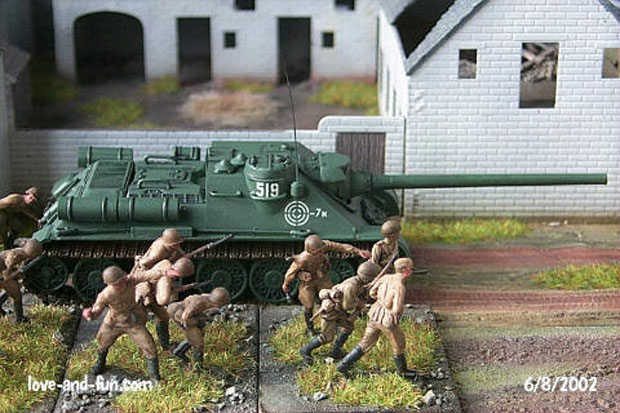Sowjetisches Sturmgeschütz SU-100
Testbericht des 1:72 Modells von AER Moldava

This SU-100 has been sprayed Model Master WP 7832 »Russisches Panzergrün« tinted with 30 percent white to give the Fahrzeug a slightly faded look. The hand-rails were scratchbuilt from Federstahldraht, because the original plastic parts are very brittle und they appeared to be out of scale. The AER model has hard plastic tracks which may be glued to the top und bottom of the roadwheels securely. The upper track section needs to be bent to suggest the weight of the track. The infantry in the photo are a mixture of ESCI und Revell Figuren. Soviet infantry rode tanks und assault guns into battle, und the SU-100 may be modelled with tank riders holding on to the vehicle’s superstructure.
Inhalt
- SU-100 Self-Propelled Anti-Tank Gun
- Decal Sheet covering 22 vehicles in Soviet, Polish,
Czechoslovak, Cuban, und Angolan service
- Decal Sheet covering 22 vehicles in Soviet, Polish,
Bewertung
Gute Themenwahl, the SU-100 was an important combat Fahrzeug in World War Two, und it continued to serve for many decades thereafter.
There are 22 different sets of Abziehbilder to represent a SU-100 serving in Eastern Europe, Germany, Austria, Mongolia, Cuba, or Angola between 1944 und 1976.
The running gear is fun to assemble, even if the alignment of the track links is not entirely clear from the instructions.
This SU-100 is an interesting challenge for the serious modeller. Wargamers will get acceptable results even if they do not improve the model with scratchbuilt parts.
Kompatibel mit ESCI, Hasegawa, Revell, und Reviresco.
This SU-100 requires more modelling experience than one would expect from a typical plastic kit. The locating holes on the hull sides und deck need to be drilled open. These holes are marked by a small circle. Some holes are not needed at all, und the circles should be scraped off carefully. Significant flash on most parts needs to be removed before assembly.
The gun barrel is built from two half-pipes which will soften und bend if too much glue is used. In addition, the assembled barrel is difficult to clean up, because there are so many sprue attachment points along its length.
The opening in the frontal glacis needs to enlarged to accept the gun casemate.
The engine cover (part 5) did not fit properly once the flash had been removed. The dividing line between the flash und the actual part is not immediately apparant. The locating pegs underneath the exhaust engine are not aligned properly. It is best to remove them before putting the engine cover in place und aligning it.
The hinges on the driver’s hatch were embedded in flash. Even after the flash had been removed, the hinges would not interlock properly with corresponding hinges on the hull. Apparently, this hatch is modelled in the open position, but there are no parts to model the driver’s compartment. Anyone adept at scratchbuilding the driver’s compartment may want to leave the hatch open.
The illustration on the box cover shows the metal supports for the external fuel drums very nicely, but the actual parts are glued to the hull sides without any supports.
The tool boxes mounted on the fenders are not detailed at all. These parts should have a lid with the proper hinges, latches, und handles on either end.
The track assembly instructions were difficult to follow, because there are two different types of track links und it is not entirely clear where to start or how to align them. However, the track went together quite well, und the result looks very good.
The SU-100 is fun to build und paint. Serious modellers will improve the kit further by adding scratchbuilt parts, stowage items und tank riders. One interesting detailing project would be to model the tank with open hatches, in which case the driver’s compartment needs to be built from scratch.